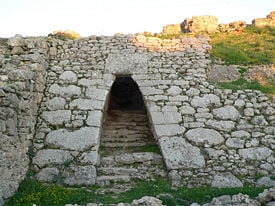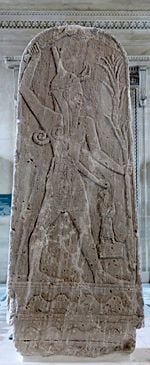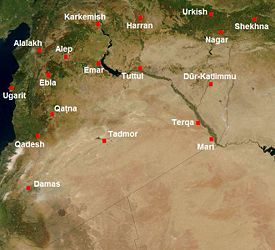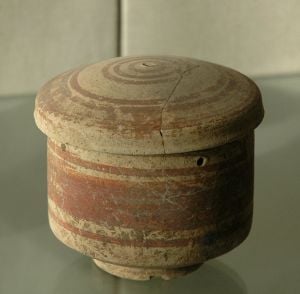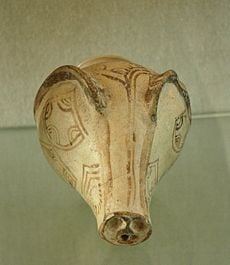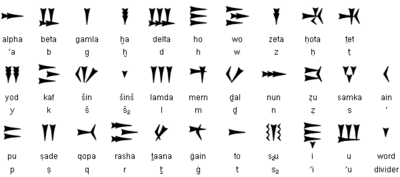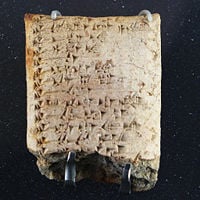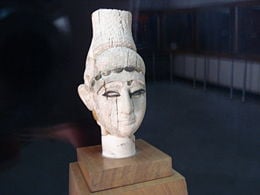Ugarit
Ugarit (modern Ras Shamra near Latakia, Syria) was an ancient cosmopolitan port city, sited on the Mediterranean coast. The polity was at its height from ca. 1450 B.C.E. until 1200 B.C.E.
Rediscovered in 1928, the site has yield a treasure trove of archaeological information, including a library of thousands of clay tablets in several ancient languages. The most significant of these finds was the religious text known Baal Cycle, which details the mythology of several Canaanite gods and provides previously unknown insights into the religious culture opposed by the writers of the Bible.
Ugarit maintained trade and diplomatic connections with Cyprus (called Alashiya) and at times sent tribute to Egypt, as documented in the archives recovered from the site and corroborated by Mycenaean and Cypriot pottery found there.
Archaeological site
Ugarit's location was forgotten until 1928 when an Alawite peasant accidentally opened an old tomb while plowing a field. The discovered area was the Necropolis of Ugarit, located in the nearby seaport of Minet el-Beida. Excavations have since revealed an important city that takes its place alongside Ur and Eridu as a cradle of urban culture. Its prehistory reaches back to ca. 6000 B.C.E., perhaps because it was both a port an entrance to the inland trade route to the inland centers which lay on the Euphrates and Tigris rivers.
Most early excavations of Ugarit were undertaken by archaeologist Claude Schaeffer from the Prehistoric and Gallo-Roman Museum in Strasbourg. The digs uncovered a major royal palace of 90 rooms, laid out around eight enclosed courtyards, many ambitious private dwellings, and libraries. Crowning the hill where the city was built were two main temples: one to Baal the "king" and one to Dagon, the god of fertility and wheat. The most important piece of literature recovered from Ugarit is arguably the Baal Cycle text, describing the basis for the religion and cult of the Canaanite Baal and the dramatic myth of his ascendancy to the head of the pantheon of Canaanite deities.
The site yielded several deposits of cuneiform clay tablets, discovered at a palace library, a temple library and—apparently unique in the world at the time—two private libraries, all dating from the last phase of Ugarit, around 1200 B.C.E. One of the private libraries belonged to a diplomat named Rapanu and contained legal, economic, diplomatic, administrative, literary, and religious texts.
Sometimes known as the Ras Shamra Tablets, the texts found at Ugarit were written in four languages: Sumerian, Hurrian, Akkadian, and Ugaritic (of which nothing had been known before). No less than seven different scripts were in use at Ugarit: Egyptian and Luwian hieroglyphics, and Cypro-Minoan, Sumerian, Akkadian, Hurrian, and Ugaritic cuneiform. During excavations in 1958, yet another library of tablets was uncovered. These were, however, sold on the black market and not immediately recovered.
The Ras Shamra Tablets are now housed at the Institute for Antiquity and Christianity at the Claremont School of Theology in Claremont, California. They were edited by Loren R. Fisher in 1971. In 1973, an additional archive containing around 120 tablets was discovered during rescue excavations. In 1994 more than 300 further tablets were discovered in a large stone building on the site, covering the final years of the Bronze Age city's existence.
History
Though the site is thought to have been inhabited earlier, Neolithic Ugarit was already important enough to be fortified with a wall early on, perhaps by 6000 B.C.E. The first written evidence mentioning the city comes from the nearby city of Ebla, ca. 1800 B.C.E. By this time Ugarit had passed into the sphere of influence of Egypt, which deeply influenced its art.
The earliest Ugaritic contact with Egypt (and the first exact dating of Ugaritic civilization) comes from a carnelian bead found at the site which had been identified with the Middle Kingdom pharaoh Senusret I, 1971–1926 B.C.E. A stela and a statuette from the Egyptian pharaohs Senusret III and Amenemhet III have also been found. However, it is unclear at what time these monuments arrived at Ugarit. Letters discovered at Amarna dating from ca. 1350 B.C.E. include one letter each from the King Ammittamru I of Ugarit and his queen, Niqmaddu II. During its high culture, from the sixteenth to the thirteenth century B.C.E., Ugarit remained in constant touch with Egypt and Cyprus (then called Alashiya).
Destruction
The last Bronze Age king of Ugarit, Ammurapi, was a contemporary of the Hittite king Suppiluliuma II. The exact dates of his reign are unknown. However, a letter by the king is preserved, in which Ammurapi stresses the seriousness of the crisis faced by many Near Eastern states from invasion by the advancing Sea Peoples. Ammurapi highlights the desperate situation Ugarit faced in letter RS 18.147, written in response to a plea for assistance from the king of Alasiya.:
My father, behold, the enemy's ships came (here); my cities were burned, and they did evil things in my country. Does not my father know that all my troops and chariots are in the Land of Hatti, and all my ships are in the Land of Lukka?... Thus, the country is abandoned to itself. May my father know it: the seven ships of the enemy that came here inflicted much damage upon us.[1]
Evidence suggests that Ugarit was burned to the ground at the end of the Bronze Age. An Egyptian sword bearing the name of pharaoh Merneptah was found in the destruction levels. However, a cuneiform tablet found in 1986 shows that Ugarit was destroyed after the death of Merneptah. It is now generally agreed that Ugarit had already been destroyed by the eighth year of Ramesses III in 1178 B.C.E.
The destruction was followed by a hiatus in settlement at Ugarit. Many other Mediterranean cultures were deeply disordered at the same time, apparently by invasions of the mysterious "Sea Peoples."
Alphabet
Scribes in Ugarit appear to have originated the Ugaritic alphabet around 1400 B.C.E. It consisted of 30 letters, corresponding to sounds, and was adapted from cuneiform characters and inscribed on clay tablets. A debate exists as to whether the Phoenician or Ugaritic alphabet was invented first. Evidence suggests that the two systems were not wholly independent inventions. Later, it would be the Phoenician alphabet that spread through the Aegean and on Phoenician trade routes throughout the Mediterranean. The Phoenician system thus became the basis for the first true alphabet, when it was adopted by Greek speakers who modified some of its signs to represent vowel sounds as well. This system was in turn adopted and modified by populations in Italy, including ancestors of the Romans).
Compared with the difficulty of writing Akkadian in cuneiform—as exemplified in the Amarna Letters from ca. 1350 B.C.E.—the flexibility of an alphabet opened a horizon of literacy to many more kinds of people. In contrast, the syllabary (called Linear B) used in Mycenaean Greek palace sites at about the same time was so cumbersome that literacy was limited largely to administrative specialists.
Language and culture

The Ugaritic language is attested in texts from the fourteenth through the twelfth century B.C.E. Ugaritic is a Northwest Semitic language, related to Hebrew and Aramaic. However, its grammatical features are similar to those found in classical Arabic and Akkadian. It possesses two genders (masculine and feminine), three cases for nouns and adjectives (nominative, accusative, and genitive); three numbers: (singular, dual, and plural); and verb aspects similar to those found in other Western Semitic languages.
Apart from royal correspondence to neighboring Bronze Age monarchs, Ugaritic literature from tablets found in the libraries of Ugarit include mythological texts written in a narrative poetry, letters, legal documents such as land transfers, international treaties, and a number of administrative lists. Fragments of several poetic works have been identified: the "Legend of Kirtu," the "Legend of Danel," the religious texts that describe Baal-Hadad's conflicts with Yam and Mot, and other fragments.
The discovery of the Ugaritic archives has been of great significance to biblical scholarship, as these archives for the first time provided a detailed description of Canaanite religious beliefs during the period directly preceding the Israelite settlement. These texts show significant parallels to biblical literature. Ugaritic poetry has many elements later found in Hebrew poetry in its use of parallelism, meter, and rhythms. Titles and descriptions of Ugaritic deities also bear a marked similarity to the imagery used by the biblical writers. The discoveries at Ugarit have thus led to a new appraisal of the Old Testament as literature.
Religion
Ugaritic religion centered on the chief god, Ilu or El, whose titles included "Father of mankind" and "Creator of the creation." The Court of El was referred to as the 'lhm or Elohim, a word later used by the biblical writers to describe the Hebrew deity and translated into English as "God," in the singular.
Beside El, the most important of the other gods were the Lord and king of the god Baal-Hadad, the mother goddess Athirat or Asherah, the sea god Yam, and the desert god of death Mot. Other deities worshiped at Ugarit included Dagon (grain), Resheph (healing), Kothar-and-Khasis (the divine craftsman), Shahar (dawn or the sun), Shalim (dusk), and Tirosh (grapes).
El, which was also the name of the God of Abraham, was described as an aged deity with white hair, seated on a throne. Although El was the highest deity and the father of many of the other gods, he had bequeathed the kingship of the gods to Baal when Baal had defeated the previous incumbent, Yam, who had turned tyrant and attempted to claim El's wife Asherah as his consort. At Ugarit, Baal was known by several titles: “king of the gods,” “the Most High (Elyon),” “Prince Baal," and “the Rider on the Clouds.”
Kings of Ugarit
| Ruler | Reigned | Comments |
|---|---|---|
| Niqmaddu I | ||
| Yaqurum I | ||
| Ibiranu I | ||
| Ammittamru I | ca. 1350 B.C.E. | |
| Niqmaddu II | 1349 - 1315 B.C.E. | Contemporary of Suppiluliuma I of the Hittites |
| Arhalba | 1315 - 1313 B.C.E. | |
| Niqmepa | 1312 - 1260 B.C.E. | Treaty with Mursili II of the Hittites, Son of Niqmadu II, |
| Ammittamru II | 1260 - 1235 B.C.E. | Contemporary of Bentisina of Amurru, Son of Niqmepa |
| Ibiranu | 1235 - 1220 B.C.E. | |
| Niqmaddu III | 1220 - 1215 B.C.E. | |
| Ammurapi | ca. 1200 B.C.E. | Contemporary of Chancellor Bay of Egypt, Ugarit is destroyed |
See also
Notes
- ↑ Jean Nougaryol et. al. (1968) Ugaritica V: 87-90 no.24
ReferencesISBN links support NWE through referral fees
- Bourdreuil, P. 1991. "Une bibliothèque au sud de la ville : Les textes de la 34e campagne (1973)." in Ras Shamra-Ougarit, 7 (Paris).
- Drews, Robert. 1995. The End of the Bronze Age: Changes in Warfare and the Catastrophe ca. 1200 B.C.E. (Princeton University Press). ISBN 0-691-02591-6
- Meletinskii, E. M., 2000 The Poetics of Myth
- Sanford Holst. "Phoenicians: Lebanon's Epic Heritage," Cambridge and Boston Press, Los Angeles, 2005.
- Smith, Mark S., 2001. Untold Stories ; The Bible and Ugaritic Studies in the Twentieth Century ISBN 1-56563-575-2 Chapter 1: "Beginnings: 1928–1945"
- Ugarit Forschungen (Neukirchen-Vluyn). UF-11 (1979) honors Claude Schaeffer, with about 100 articles in 900 pages. pp 95, ff, "Comparative Graphemic Analysis of Old Babylonian and Western Akkadian," ( i.e. Ugarit and Amarna (letters), 3 others, Mari, OB,Royal, OB,non-Royal letters). See above, in text.
- Virolleaud, Charles, 1929. "Les Inscriptions cunéiformes de Ras Shamra." in Syria 10, pp 304-310.
- Yon, Marguerite, 2005. The City of Ugarit at Tell Ras Shamra ISBN 1-57506-029-9 (Translation of La cité d'Ugarit sur le Tell de Ras Shamra 1979)
External links
- Online text: The Epic of Ba'al
- The Edinburgh Ras Shamra project includes an introduction to the discovery of Ugarit.
- Ugarit and the Bible
- Ugaritic Literature as an Aid to Understanding the Hebrew Bible (Old Testament)
- About the discovery of Ugarit
- Ugaritic culture, cult and art briefly outlined.
- Introduction to Ras Shamra (Ugarit), and a virtual museum of Ugaritic art.
- Resources on Biblical Archaeology
- Canaanite/Ugaritic Mythology
- Ugarit and Biblical Heritage - A site with descriptions of the primary and minor gods and generous excerpts from the actual stories.
- Brief history of Ugarit.
- Ugaritic texts and their relationship to the Old Testament.
- Le Royaume d'Ougarit (in French)
Credits
New World Encyclopedia writers and editors rewrote and completed the Wikipedia article in accordance with New World Encyclopedia standards. This article abides by terms of the Creative Commons CC-by-sa 3.0 License (CC-by-sa), which may be used and disseminated with proper attribution. Credit is due under the terms of this license that can reference both the New World Encyclopedia contributors and the selfless volunteer contributors of the Wikimedia Foundation. To cite this article click here for a list of acceptable citing formats.The history of earlier contributions by wikipedians is accessible to researchers here:
The history of this article since it was imported to New World Encyclopedia:
Note: Some restrictions may apply to use of individual images which are separately licensed.
